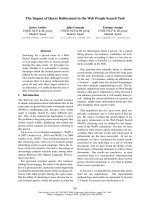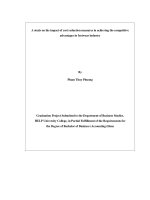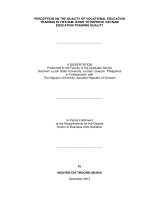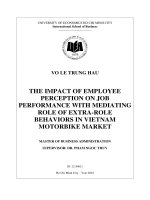The impact of employee perception on job performance with mediating role of extra role behaviors in vietnam motorbike market
Bạn đang xem bản rút gọn của tài liệu. Xem và tải ngay bản đầy đủ của tài liệu tại đây (561.63 KB, 66 trang )
UNIVERSITY OF ECONOMICS HO CHI MINH CITY
International School of Business
------------------------------
VO LE TRUNG HAU
THE IMPACT OF EMPLOYEE
PERCEPTION ON JOB
PERFORMANCE WITH MEDIATING
ROLE OF EXTRA-ROLE
BEHAVIORS IN VIETNAM
MOTORBIKE MARKET
MASTER OF BUSINESS ADMINISTRATION
SUPERVISOR: DR. PHAM NGOC THUY
ID: 22150021
Ho Chi Minh City – Year 2018
Acknowledgement
Apart from the efforts of me, the on time completion of the thesis largely on the
encouragement and guidelines of many others. I take this opportunity to express
my gratitude to the people who have been instrumental in the successful
completion of this thesis.
I would like to express my appreciation to Dr. Pham Ngoc Thuy – my
instructor. She provided me with tremendous support, help and motivations. Without
her instructions and guidance, I would not finish this thesis.
The guidance and supports received from ISB, classmates, friends and
family are also very important to me. I am grateful for their constant support and
help.
1
The impact of employee perception on job performance with mediating role of
extra-role behaviors in Vietnam motorbike market
Abstract
This study examines the impact of employee perception of conscientiousness,
organizational justice and organizational identification on job performance of
frontline employee in the context of Vietnam motorbike retail market. It also
investigates the mediation effect of customer-directed and employee-directed extrarole behavior on above relationships. By using structural equation modeling, these
impacts were empirically tested with a sample of 252 frontline employees working at
motorbike retail dealers in Vietnam. The result reveals conscientiousness,
organizational justice and organizational identification as positive predictors of job
performance. Furthermore, the relationships are indicated to mediate by extra – role
behaviors. Overall, the mediating effect of customer – directed extra – role behaviors
are stronger than employee – directed extra – role. The impact of conscientiousness
and organizational justice to job performance was mediated by both extra – role
behaviors. In the other hand, while this study shows the mediation effect of customerdirected extra-role behavior on the relationship of organizational identification and
job performance, the mediation effect of employee-directed extra-role behaviors on
the relationship is not support.
Key words: conscientiousness, organizational justice, organizational
identification, extra-role behaviors, job performance, Vietnam motorbike retail
2
Table of content
1. Introduction........................................................................................................................................... 5
2. Theoretical background and hypotheses.................................................................................... 9
2.1. Employee perception and job performance model........................................................ 9
2.2. Extra-role behaviors............................................................................................................... 10
2.3. Conscientiousness as employee perception................................................................... 11
2.4. The Perception of Organizational justice and organizational identification .. 12
2.5. The mediating role of extra-role behaviors................................................................... 13
3. Research method............................................................................................................................... 16
3.1. Research procedure................................................................................................................ 16
3.2. Data collection and sample................................................................................................. 17
3.3. Measurement scale.................................................................................................................. 19
4. Analysis and results......................................................................................................................... 21
4.1. Scale validation........................................................................................................................ 21
4.2. Structural Equation Modeling............................................................................................ 23
5. Theoretical Implication.................................................................................................................. 27
6. Managerial implication................................................................................................................... 31
7. Limitation and future research..................................................................................................... 33
8. Conclusion........................................................................................................................................... 34
Appendix A: Sources of questionnaire item................................................................................. 35
Appendix B: Pilot research guidelines and revised questionnaires (English version) 37
Appendix C: Survey form and questionnaires (Vietnamese version)................................. 40
Appendix D: List of motorbike retail store taking place in quantitative research..........42
Appendix E: CFA result of measurement scale (standardized)............................................. 44
Appendix F: SEM result of direct model....................................................................................... 45
Appendix G: SEM weights and standardized result of structural model...........................46
Appendix H: Standardized result of structural model............................................................... 47
Reference.................................................................................................................................................... 48
3
List of table and figure
Figure 1: Proposed model.................................................................................................................... 10
Table 1: Demographic information of sample.............................................................................. 19
Table 2: Cronbach’s Alpha of factors.............................................................................................. 21
Table 3: Composite reliable, average variance extracted and correlation......................... 23
Figure 2: standardized path coefficient of the direct relationship......................................... 24
Figure 3: structural model of mediation mechanism................................................................. 25
Table 4: Direct effect and indirect effect of hypothesis relationship................................... 27
4
1. Introduction
With the rapid growing and urbanization, Vietnam motorbike market has developed
significantly in both production and consume over the past decade. As a developing
country, Vietnamese people still use motorbike as main transportation vehicle which
every household have at least one motorbike, usually more than one. As a result, Vietnam
motorbike market becomes an intriguing location for investors which the competition is
intense between foreign motorbike makers as well as between domestic motorbike
retailers. Most notably, there was a fierce competition between Chinese manufacturers
and Japanese manufacturer early 2000s which Chinese motorbike makers changed the
context of motorbike industry with their low price strategy (Nguyen, 2007). Under such
circumstance, the current leading Japanese suppliers had to respond to the challenge by
developing sustainable competitive advantages through their internal resources (Nguyen,
2007). Recently, the context of Vietnam motorbike industry continues to develop a
significant ground of competition between foreign suppliers which contains of 5 major
brand names such as Honda, Yamaha, Suzuki, SYM and Piaggio. According to the report
of Vietnam Association of Motorcycles Manufactures (2018), the total sales volume of 5
major manufactures in 2017 was over 3.2 million motorbikes (1). Due to the dynamic of
the competition, Vietnam motorbike retailers understand that they have to keep evolving
and improving to adapt to the changing market and retain their market share. Considering
the important of human capital as a sustainable competitive advantage, it is vital for
Vietnam motorbike retailers in to enhance their knowledge about frontline employee in
order to
5
optimize their decision – making process regarding recruitment, training
and evaluation.
The role of frontline employee is widely agreed as critical factors to the
success of organizations in various contexts such as retail, banking or service
(Lindblom, Kajalo & Mitronen, 2016; Handa & Gulati, 2014; Wallace, de
Chernatony & Buil, 2011). Bagdare (2015) indicates that frontline employee is
the most significant determinants of retail customer mood and shopping
emotional experience. According to Steffen and Atorough (2015), frontline
employee is the key driver of the customer loyalty and satisfaction which were
inevitable to train a proficient and sociable frontline employee to avoid negative
behaviors from customers. However, most previous studies only examine
companies in developed country, neither or limited studies investigate Vietnam
market or Vietnamese organizations. Various researchers and practitioners insist
to apply these framework models in other cultural locations and settings which
might generalize difference results and improve our understanding of profound
knowledge (Reychav & Sharkie, 2010; Usmani & Jamal, 2013; Maxham,
Netemeyer & Lichtenstein., 2008). This paper’s goal is to further the exposure of
literature by examining both employee perception and extra-role behaviors as
the antecedents of frontline employee job performance in the context of
motorbike retail in Vietnam.
It is a well-known fact that employee perception influence employee attitude
and behaviors during their day-to-day performance (Lindblom et al., 2016; Reychav &
Sharkie, 2010). If the employees have a positive perception of the organization,
6
they are more likely to perform discretionary behaviors which eventually improve
individual performance (Elorza et al., 2016). Punia (2011) indicates that high
performers would be more likely to have a good perception of their work and
organization. In the literature of retail, there are 3 possible constructs of employee
perception that impact job performance, such as conscientiousness, organizational
justice and organizational identification. Particularly, the personality trait of
conscientiousness is considered as the employee perception of their wellbeing and
responsibility toward their job (Handa & Gulati, 2014). Otherwise, organizational
justice and organizational identification are included as perspective and feeling of
frontline employee toward their supervisor and organization which motivated
them for higher performance (Usmani & Jamal, 2013; Lichtenstein, Netemeyer &
Maxham 2010). Arguably, employee perceptions are important determinants of
employee positive behavior as well as job performance.
Extra – role behaviors are another important asset which significantly enhance
the result of frontline employee in retail context. Generally, there are two distinct
categories in the study of employee job performance, including in-role behaviors and
extra-role behaviors. While in-role behaviors refer to task performance directly
related to job description, extra-role behavior is a set of behaviors that go beyond
their obligations to contribute to their organization (Wallace et al., 2011). Other
researches has focused on extra-role behaviors as discretionary behavior to measure
the outcome of employee (Elorza, Harris, Aritzeta and Balluerka, 2016; Wallace et al.,
2011; Maxham et al., 2008). The definition of extra-role behaviors is extended to
which employees go beyond their role to help customers as well as their co-workers
7
(Reychav & Sharkie, 2010). Despite the important of extra – role behaviors toward job
performance, the understanding of extra – role behaviors, especially in motorbike retail
in Vietnam, is quite vague. With the high demand of motorbike in Vietnam, many
motorbike retail store tend to focus only on the profit rather than strategy to develop
their human capital. From the observation of author, frontline employees at retail store in
Vietnam have the tendency to do nothing or provide minimum supportive to their
customers. Some employees only come to work to finish their daily task while don’t
show any dedication to the overall success of their organization. Although the
performance of employees and retail store still keep an acceptable sales result at the
moment, it’s necessary for motorbike retailers to understand and focus on different
components of their employee performance for long-term and sustaining success.
Therefore, this study includes extra-role behaviors in the performance model to explore
their impact to frontline employee in Vietnam motorbike industry. Both customerdirected and employee-directed extra – role behaviors are accounted as the determinants
of frontline employee’s job performance.
To summary, the present study aims to investigate how employee perception of
conscientiousness, organizational justice and organizational identification influence
behaviors and job performance of frontline employees in motorbike retail stores. The
objective is to examine a number of possible employee perceptions that could improve
frontline employee’s job performance. Moreover, this study will also investigate extrarole behaviors toward employee and customer as mediator in the relationship of
employee perceptions and job performance. These finding will
8
help to optimize human capital resources of motorbike retail store tin Vietnam
through better recruitment, HR decision, training and evaluation
2. Theoretical background and hypotheses
2.1 Employee perception and job performance model
Employee Perception is widely argued as the antecedent of higher performance level
as well as the behaviors and motivation of employee (Lichtenstein et al., 2010; Punia,
2011; Haumann, Ahearne & Wieseke, 2015). The study of Lindblom et al. (2016)
focuses the relationship between employee perception and employee job
performance by examining the perception of charismatic leadership. Similarly,
perception of trust is indicated to be a significant factor of employee discretionary
behavior (Reychav & Sharkie, 2010). Extending research has stated the strong
influence of employee perception to employee job satisfaction which has positive
effect to employee job performance (Usmani & Jamal, 2013).
After reviewing the retail literature of employee perception, this study
adapted three categories of employee perceptions from the model of Maxham et al.
(2008) that can positive impact employee behavior and job performance in their
investigation of retail value chain. There are three constructs of employee
perceptions including in this study which are the perception of (1)
conscientiousness, (2) organization justice and (3) organization identification. Thus,
the present study proposes a model to support above relationship in Figure 1. The
model also hypothesizes that extra-role behaviors which included employeedirected and customer-directed extra – role behaviors will have a mediating role in
the relationship of employee perception and job performance.
9
Figure 1: Proposed model
2.2 Extra-role behaviors
Extra-role behaviors have been considered as main component of employee job
performance in previous literature (Wallace et al., 2011). Extra-role behavior is
defined as the willingness of employee to perform voluntary task that do not require
in job description to improve their performance as well as collaborate with their
colleague to help customers (Bettencourt & Brown, 2003). Likewise, extra-role
behaviors are emphasized as an important facet of frontline employee performance in
retail banking (Wallace et al., 2011). To put it simply, extra-role behaviors referred to
the volitional acts of employee that benefit both organization and other stakeholders,
including colleagues and customers. Particularly, extra – role behaviors are defined by
studies as employee’s attitude and obligation toward organization or known as
Organization Citizen Behaviors (OCB) which influenced the wellbeing of the
organization and other colleague (Bowling, 2010). Reychav and Sharkie (2010)
verified the benefits of extra – role behaviors which frontline employee was more
10
likely to participate in decision making process and sharing knowledge to other
employee in order to contribute to organization’s overall performance. Other studies
viewed extra – role behaviors as characteristic of customer orientation which positively
impact the relationship between customer and frontline employee (Sulea, Virga,
Maricutoiu, Schaufeli, Catalina, & Sava, 2012). With that perspective, current study will
account both employee-directed and customer-directed extra-role behavior as a positive
determinant of job performance to examine their mediation effect.
2.3 Conscientiousness as employee perception
Although known as a personality trait, the impact of conscientiousness as employee
perception is well-studied. According to Auh, Menguc, Fisher and Haddad (2011),
conscientiousness would enhance employee perception of service climate which
increase customer’s satisfaction and purchase intention. Other research find that
conscientiousness impact employee perception as well as job performance in a
positive way, whereas conscientious employee was more likely to act as a competence
and dependable individual (Bernerth, Armenakis, Feild, Giles & Walker, 2007).
Recent study also stressed the role of conscientiousness that could influence
perception and engagement of employee in difference scenarios at a retail store
(Handa & Gulati, 2014). In other word, conscientiousness was the individual
perception which demonstrates how employee perceived their work responsibility and
environment. Thus,
H1: Conscientiousness has a positive impact to job performance
11
2.4 The Perception of Organizational justice and organizational identification
Both organizational justice and organizational identification represent perspective and
feeling of employee toward their supervisors and organization. Particularly,
organizational justice reflects the feeling and reactions of employee on how they were
treated by their employer and organization in term of fairness and equality (Wang,
Liao, Xia & Chang, 2010). The concept of organization justice is specified into three
main dimensions, including distributive, procedural and interactional justice (Usmani
& Jamal, 2013; Wang et al., 2010). Other researches show the relationship between
organization justice and job satisfaction through examining banking employee
(Usmani & Jamal, 2013). Likewise, Elamin (2012) indicates the correlation of
organizational justice with employee job satisfaction and commitment. According to
Wang et al. (2010), organizational justice affects employee job performance with the
mediation of job commitment. In their study, Aizzat and Soon (2011) point out the
significant effect of organizational justice on job performance in Malaysia. As a
result, current study argues the positive effect of organizational justice to frontline
employee’s job performance in motorbike retail context in Vietnam. Thus, H2:
Organizational Justice has a positive impact to job performance
Correspondingly, organizational identification is regarded as how employee
defined themselves in organization as well as their perception of organization’s goal
and vision (Lichtenstein et al., 2010; Karanika-Murray, Duncan, Pontes & Griffiths,
2015). Like organizational justice, organizational identification is reported to have
positive relationship with job satisfaction and employee engagement (KaranikaMurray et al., 2015). Karanika-Murray et al. (2015) discussed that organization
12
identification improved employee job performance by increasing their
engagement and dedication to their work and organization. According to the study
of Kraus, Haumann, Ahearne & Wieseke (2015), the study’s result showed
significant influence of organizational identification to satisfaction of customer
through the affection of frontline employee performance. In retail context, store
financial performance was impacted by the level of identification of store manager
and employee toward their organization (Lichtenstein et al., 2010). Current study
hypothesized the positive relationship of organizational identification and job
performance. Thus,
H3: Organizational Identification has a positive impact to job performance
2.5 The mediating role of extra-role behaviors
Although efforts have been done to prove the influence of employee perception to
extra-role behaviors or extra – role behaviors as a positive antecedents of job
performance, few studies had examined extra – role behaviors as mediator in the
relationship of employee perception and job performance. Therefore, this study
attempted to investigate mediation effect of both employee – directed and customer –
directed extra – role behaviors in the connection between employee perception and
job performance. In order to investigate the mediation effect of extra-role behaviors,
the study followed the process suggested by Baron and Kenny (1986) who were
simplified by Zhao, Lynch and Chen (2010). Firstly, the employee perception of
conscientiousness, organizational justice and organizational identification was proved
to be a positive predictor to job performance which would be tested in H1, H2 and
H3. Second, the indirect effect and directed of employee perception to job
13
performance with the mediator would be checked to prove the hypothesis. Many
evidences support positive influence of conscientiousness to extra-role behaviors of
frontline employee which presented their tendency to go beyond the “call of duty” to
help customer or support their co - worker. A high conscientiousness employee is
more likely to be more engage with their organization as well as work harder to
achieve their target (Bowling, 2010). Furthermore, conscientiousness is emphasized
by Phipps, Prieto and Deis (2015) as a strong factor that influence frontline
employee’s behaviors to act more helpful and supportive toward their supervisor and
colleague. Conscientiousness is also reported to have a positive impact to frontline
employee’s discretionary behaviors toward customers in retail environment which
requires a high level of social interaction (Handa & Gulati, 2014). Therefore, based
on theory of literature discussed above, this study was expected to find that
employee-directed extra – role behaviors and customer-directed extra – role behaviors
would mediate the relationship between conscientiousness and job performance
H4: The relationship of conscientiousness and job performance
is mediated by employee-directed extra-role behaviors
H5: The relationship of conscientiousness and job performance
is mediated by customer-directed extra-role behaviors
Similarly, this study continued to examine the mediation effect of extra – role
behavior on the relationship of organizational justice and job performance. Reychav
and Sharkie (2010) indicate that the employee-directed extra – role behaviors are
influence by the fairness they are felt about their organization, including the trust in
management and psychological support. Identically, the interactional justice of the
14
supervisor impacts the tendency to perform extra – role behaviors of frontline employee
significantly according to Lam and Leong (2013). Likewise, customer-directed extra –
role behaviors are also affected by organizational justice which improve frontline
employee’s attitude and behavior toward customer (Aizzat & Soon, 2011). In recent
study in hospitality context, Wen, Li and Hou (2016) indicated that if the employee was
treated fairly by their management, it will positively reflect on their extra – role
behaviors by suggesting new idea, helping other colleague as well as avoid customer
mistreating behavior. Thus, it’s fair to assume that both extra – role behaviors will
mediate the relationship of organizational justice and job performance.
H6: The relationship of organizational justice and job performance
is mediated by employee-directed extra-role behaviors
H7: The relationship of organizational justice and job performance
is mediated by customer-directed extra-role behaviors
High level of identification also prompts employee who define themselves with
organization to participate discretionary behavior (Kane, Magnusen & Perrewé,
2012). According to Kane et al. (2012), if employee has high identification with their
company, they will be expected to perform more voluntary action, including extra – role
behaviors, to help others as well as OCB which improve their efficiency and customer
satisfaction. Based on study of social identity theory, a strong connection between
frontline employee and organization is certainly influence their behavioral while also
help creating loyalty customers (Gammoh, Mallin & Bolman, 2014). Baker, Rapp,
Meyer and Mullins (2014) highlight organization identification of frontline employee as
an importance factor to develop extra – role behaviors which
15
ultimately enhance their performance. Thus, this study hypothesized the influence
of employee-directed extra-role behavior and customer-directed extra-role behavior
as mediator that affect the relationship between organizational identification and job
performance as below:
H8: The relationship of organizational Identification and job
performance is mediated by employee-directed extra-role
behaviors H9: The relationship of organizational Identification and
job performance is mediated by customer-directed extra-role
behaviors
3. Research method
3.1 Research procedure
There were two phases in procedure, including pilot phase and main phase in which
qualitative and quantitative methods are used. In the pilot phase, by reviewing
literature and definition, various multi-items scales were adapted to measure the
constructs. After translating the questionnaires from English to Vietnamese, face-toface interviews were taken place to test the initial scales with 2 frontline employees
and 2 store managers who had at least 2-year experience in current position. Depend
on their responses and suggestions, the initial scales were revised and adjust until
there were no additional revisions and the participants confirmed to be understanding
and agree with the modified scales.
In the second phase, the questionnaires were designed based on the modified
scales which various items were created to measure employee perception, extra-role
performance and job performance. The data collected in this phase were used to test
the hypotheses after being gathered and validated the level of fit by the author.
16
Then, the results of the data analysis were discussed to explain the address issues as
well as recommend a solution and practical implication for retailers and store
manager. The limitation and further research were also mentioned as last chapter in
the study.
3.2 Data collection and sample
In the pilot phase, qualitative research of the study was conduct to revise the
questionnaires in order to ensure that frontline employee at retail motorbike store
could understand as well as the content was appropriate in Vietnamese language.
Refer to Appendix B for detail guidelines of qualitative research and revised
questionnaires. According to the result, there were some adjustments in term of
wording need to be made in questionnaires for better understanding. There were also
some other issues mentioned by interviewees, such as the scale would not correctly
measure the performance of frontline employee (job performance), or some would
be not related to performance (organizational identification and organizational
justice). However, because each issue was only mentioned by one interviewee and
only based on their opinion so these items were not modified. Most of respondent
understand and agreed with the questionnaires. After revising, the final questionnaire
was composed successfully.
In quantitative phase, the data were collected by asking frontline employee
to self-evaluate through answering the questionnaire. Self-evaluate method which
has been proved to be valid in marketing and behavior literature were a widely used
method to measure frontline employee performance (Rozell, Pettijohn & Parker,
2006; Lee & Turban, 2010). The participants of the research consisted of frontline
17
employee working at motorbike retail stores in which they were given a general
explanation of definition and objective of the research as well as ensured about the
confidential of their name and answers. The questionnaires were distributed directly
by paper to the participants as the author occasionally visited retail stores in business
travel. However, most of the survey was sent through online email to the store
managers then giving to the frontline employee working at their stores. The survey
was made by Microsoft Word software and sent by email to store manager who
printed the survey for their frontline employees. After that, the paper survey was sent
back to author. There were 102 motorbike retail stores all around Vietnam which
were chosen to take part in the research. Only motorbike retail stores which were
authorized by a popular company in Vietnam (Honda) were chosen to ensure
reliability and consistent results. The survey was conduct from the second week of
July, 2017 to the end of September, 2017.
In 400 questionnaires sending to collected data, a total of 273 questionnaires
was returned which had 68.3% rate of responds. However, 21 responses were
dropped due to missing data as well as unengaged questionnaires which they chose
almost the same answers to every Likert scales items. Hence, only 252
questionnaires were able to use in the data analysis. Demographic information of the
respondents who joined the research was showed below in Table 1. According to the
table, frontline employees working in motorbike retail are fairly young which
mostly on their 20s. Moreover, because the income in the industry is also not high,
this may affect the behaviors and perception of the employee toward their store.
Future study
18
should consider include these factors as control variables to further exam the model.
Otherwise, the list of motorbike retail store was displayed in Appendix C.
Table 1. Demographic information of sample
Profile
Gender
Age
Income
Education
Experience
Marriage
3.3 Measurement scale
The variables in this study were measured by using seven-point Likert scale ranging
from (strongly disagree) to (strongly agree). The questionnaires were prepared in
English initially, before being translated in to Vietnamese.
For employee perception, Conscientiousness was measured by 4 items from
the study of employee engagement and personality of Handa and Gulati (2014). A
19
total of 13 items were used to measure organizational justice (Usmani & Jamal,
2013), including 5 items of distributive justice, 4 items of procedural justice and 4
items of interactional justice (4 items). For that reason, organizational justice was
considered as second – order factor in the measurement scale. Organizational
identification was measured with 6 items from study of Kraus et al. (2015). In cases
of extra-role behavior, both customer-directed and employee-directed extra-role
behavior were measured by 3 items each suggested by Netemeyer and Maxham
(2007). In order to examine employee job performance, the respondents were asked
to describe how they perform in term of sales accomplishment comparing with other
frontline employee by a 5-items scale (Yavas, Karatepe & Babakus, 2010). The
source of questionnaires was shown in Appendix A.
To test the structural model, current study used structural equation modeling
(SEM) analysis as main method, after confirmatory factor analysis (CFA) was
conducted to check internal consistency of the measurement scale while also took into
account the overall modelling (Lindblom et al., 2016). In order to test the mediation
effect, there were a four condition recommended by Baron and Kenny (1986) which
was widely used in mediation research, including (1) direct effect of independent
variables on dependent variables prior adding mediators, (2) the relationships between
independent variables and mediators, (3) the correlation between mediators and
dependent variables, and (4) the regression of independent variable with both
mediators and dependent variable. However, in the study of Zhao et al. (2010), they
suggested a simplified process by using SEM which examining two dimension of the
direct and indirect effect to determine the mediation effect of hypothesized
20
relationship. Bootstrapping method was also used as an additional step which take
advantage of bootstrap samples and bias-corrected to increase interval consistency to
test the mediation effect (Preacher & Hayes, 2004)
4. Analysis and results
4.1 Scale validation
In order to test the internal consistency of the scale, Cronbach coefficient alpha was
computed on each constructs as well as overall model. During the analysis, some of
items was deleted, including Con2, Iden5 and Iden6, because the Cronbach’s alpha if
these items deleted was higher than the original Cronbach’s alpha. After excluding the
deleted items, Cronbach’s alpha of the current study was 0.861 which was reliable as
it was above the recommend level of 0.7 (Nunnally & Bernstein, 1994). Cronbach’s
alpha of each construct was also shown reliability, ranging from 0.736 to 0.869. Table
2 show Cronbach’s alpha of every factor in the measurement scale.
Table 2. Cronbach’s Alpha of factors
Factor
Conscientiousness
Organizational Justice
Organizational Identification
Customer-directed Extra-role Behaviors
Employee-directed Extra-role Behaviors
Job Performance
Current study approached a two-step approach which both CFA and SEM were
conducted (Anderson and Gerbing, 1988). Firstly, CFA including all the items (with
organizational justice as second – order factor) of the scale were conducted to









